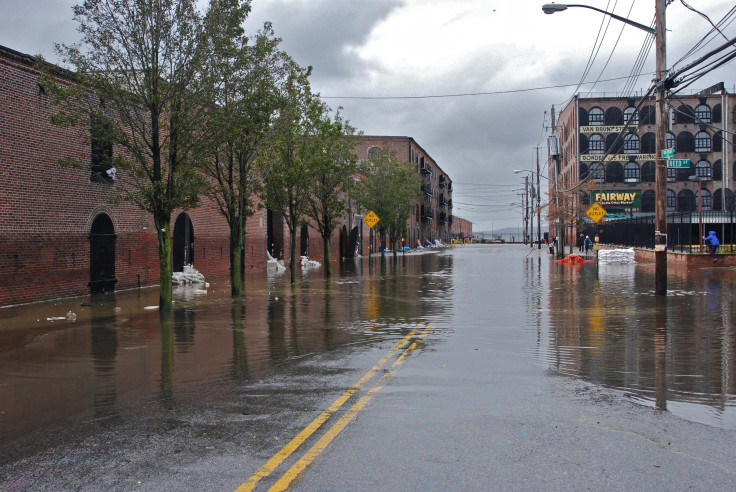Superstorm Sandy: Through The Broadcast Media Looking Glass

I only watch television news during monumental events – i.e., U.S. invasion of Iraq, the 9-11 terror attacks, Hurricane Katrina, the Los Angeles riots of 1992, the opening days of the 'Arab Spring' revolution, even the chase of OJ Simpson's white Bronco down the L.A. Freeway.
Hurricane Sandy, the most devastating storm to hit New York City in recorded history, certainly falls under the category of 'epic event' and brought me to the television for round-the-clock updates of this huge natural disaster.
Of course, trapped inside my apartment by the dangerous weather outside, I had little choice but to be glued to my TV set.
Since I wanted a purely 'localized' perspective on the tempest, I ignored the national networks and focused solely on New York City local broadcasters.
Thus, I sat mesmerized by details of the unprecedented storm while switching from NY1 to WCBS-Channel 2, WABC-Channel 7 and WNBC-Channel 4.
While I was deeply engrossed in reports of 90-mph wind gusts, surging tides, knocked out power, flooded neighborhoods, burning homes and shut-down subways, I was just as fascinated by the phenomenon of early 21st-century TV news broadcasts (and I was reminded as to why I usually shun such programs).
TV news has metamorphosed into a type of entertainment, or if you prefer 'infotainment.' It is light years away from the standards and practices espoused by Walter Cronkite and Edward R. Murrow in the pre-historic 1950s and 1960s.
Indeed, having to compete with reality programs, talk shows and sitcoms (not to mention the competitive threats posed by cable TV and the Internet), TV news programs need to generate high ratings to appeal to advertisers in order to maximize profits. Economics 101.
Consequently, they need to present the news as directly, simply (and entertainingly) as possible – delivered by the most attractive women or by the most bland and unthreatening of men.
Complex issues like war, poverty, health care, taxes, religion, crime, etc., must be reduced to the simplest of soundbytes.
Thus, hiring TV news readers is more like casting a big-budget Hollywood movie: beautiful leading ladies, handsome leading men, and perhaps a number of secondary 'comic relief' players.
Women seem to fare the worst – they are subject to the cruelest realities of modern mass media.
The majority of women on TV news are extremely attractive – there is indeed a distinct bias in favor of young slender lovelies. There appear to be scarce few women who are above the age of 45, or even 40 (much like the conventions witnessed in Hollywood and the fashion industry).
Old and/or fat females need not reply.
The industry seems to treat men much better – while a number of blandly handsome 'Ken dolls' among male TV presenters are in evidence, there are also quite a few older and 'less comely' men on screen. There are a surprising number of overweight or bald or homely or rumpled male reporters.
What is even more disturbing than this 'casting couch' approach to the hiring of TV news readers has to do with the fact that most of them are utterly devoid of personality, regionality or distinctive accents.
This is particularly true of the women – the lot of them speak in a 'corporate accent' that most closely resembles Midwest America (flat “a's,” no dropped “r's,” etc.) such that they sound like robots with no definable backgrounds.
This phenomenon becomes laughably jarring when these 'Barbie doll' reporters are required to go on the field and interview real-life people – in the context of Hurricane Sandy, watching these artificially-manicured, excessively perky young women speak to the rough-hewn residents of Brooklyn and Queens whose homes and neighborhoods were devastated by the storms was like peeking into two people from different planets speaking vastly different languages.
In addition, TV stations are now under pressure to increase 'diversity,' that is, increasing the number of ethnic minorities among the ranks of on-air talent – a crucial requirement in a highly diverse city like New York.
I did not conduct a 'survey,' but I noticed that all the local news stations have a significant number of blacks, Hispanics and Asians on staff (although whites remain the decided majority).
Nonetheless, most of the ethnic minorities who appear on screen seem to serve the purpose of 'window-dressing.' Moreover, as I alluded to before, even the minorities speak in bland, flat 'white' accents (or non-accent). Even they have been left bereft of ethnic/regional identity. To put it bluntly, they have all become 'de-racinated'.
Overall, I am very dissatisfied with the quality of TV news broadcasts – however, I admit that an event of the magnitude of Hurricane Sandy tends to lessen the worst excesses of contemporary broadcast journalism – namely, inane chit-chat and cloying sentimentality.
I hope things change by the time the next 'epic event' arrives.
© Copyright IBTimes 2024. All rights reserved.





















